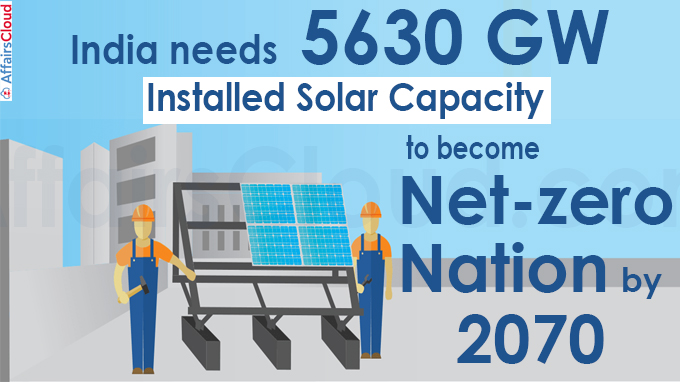 In October 2021, the Council on Energy, Environment and Water (CEEW), an independent think tank, released the “Implications of a Net-zero Target for India’s Sectoral Energy Transitions and Climate Policy” report, which predicts India to increase the total installed Solar Power Capacity to 5630 Giga Watts (GW) by 2070, to achieve Net Zero emission.
In October 2021, the Council on Energy, Environment and Water (CEEW), an independent think tank, released the “Implications of a Net-zero Target for India’s Sectoral Energy Transitions and Climate Policy” report, which predicts India to increase the total installed Solar Power Capacity to 5630 Giga Watts (GW) by 2070, to achieve Net Zero emission.
- A total land of 4.6% (approx) of India’s land is required for Solar power generation in 2070.
Note – At present, India has 100 GW of installed Renewable Energy (RE) capacity (40GW Solar) & targets to attain 450GW RE capacity by 2030
Report Findings:
i.Net Zero by 2070 –
- Coal power generation to peak by 2040 & drop 99% between 2040-2060.
- Crude Oil sector to peak by 2050 & fall by 90% between 2050-2070.
- Green Hydrogen should contribute 19% of energy consumption in the Industrial sector.
ii.Economic Cost for Transition –
- Estimated to be of 4.1% of National GDP of 2070
- Cost increases to 7% of National GDP, incase net-zero year in 2050
iii.Electric passenger vehicles would comprise 84% of all cars sold in India, while 79% of all trucks would run on battery-electric technology & rest on hydrogen.
iv.India’s Electricity generation capacity in wind and nuclear energy should increase to 1792 GW and 225 GW, respectively by 2070.
v.India needs to develop recycling capacities to handle Solar PhotoVoltaic waste generated.
Recent Related News:
India added 12.1 GigaWatt (GW) power generation capacity in 2020-21, of which 7.7 GW was from renewable energy sources (64%), followed by coal/lignite (3.9 GW) segment, according to ‘Market Handbook 2020-21’ released by CEEW-Centre for Energy Finance (CEEW-CEF)
About Council on Energy, Environment and Water (CEEW):
CEO – Arunabha Ghosh
Founded – 2010
Head Office – New Delhi




